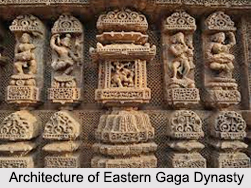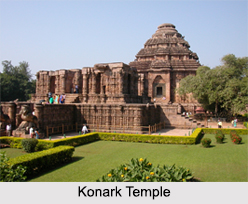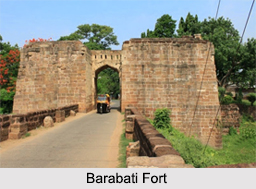 Medieval History of Odisha was introduced by Gajapati Empire. The art and architecture of Gajapati Kingdom is now the torch bearer of the cultural heritage of Odisha.
Medieval History of Odisha was introduced by Gajapati Empire. The art and architecture of Gajapati Kingdom is now the torch bearer of the cultural heritage of Odisha.
Gajapati Dynasty
The Gajapati Dynasty was a medieval Hindu dynasty from India that ruled over Kalinga (present Odisha), large parts of Andhra Pradesh and West Bengal, and the eastern and central parts of Madhya Pradesh and Jharkhand from 1434 to 1541. The Gajapati dynasty was established by Kapilendra Deva (1434-66) in 1434.
Eastern Ganga Dynasty in Odisha
 The Eastern Ganga Dynasty was followed by the Gajapati Kingdom. The region resisted integration into the Mughal empire until 1568, when it was conquered by Sultanate of Bengal. Mukunda Deva, who is considered the last independent king of Kalinga, was defeated and was killed in battle by a rebel Ramachandra Bhanja. Ramachandra Bhanja himself was killed by Bayazid Khan Karrani. In 1591, Man Singh I, then governor of Bihar, led an army to take Odisha from the Karranis of Bengal.
The Eastern Ganga Dynasty was followed by the Gajapati Kingdom. The region resisted integration into the Mughal empire until 1568, when it was conquered by Sultanate of Bengal. Mukunda Deva, who is considered the last independent king of Kalinga, was defeated and was killed in battle by a rebel Ramachandra Bhanja. Ramachandra Bhanja himself was killed by Bayazid Khan Karrani. In 1591, Man Singh I, then governor of Bihar, led an army to take Odisha from the Karranis of Bengal.
Odisha under the Nawab of Bengal
The territory of modern day Odisha and Bihar was ruled by the Nawabs of Bengal, including Bengal proper, Bihar and Odisha. Odisha was the first subah (imperial top-level province) added to Akbar`s fifteen by Shah Jahan. It had Cuttack as seat and bordered Bihar, Bengal and Golconda subahs as well as the remaining independent and tributary chiefs. From 1717, the Odisha and Bijar governors were reduced to deputies of the Nawab of the pseudo-autonomous Bengal Subah. In 1751, the Nawab of Bengal, Alivardi Khan ceded the region to the Maratha Empire.
Bhoi Dynasty
 Bhoi Dynasty was founded by Govinda Vidyadhara who came to throne in a bloody coup, in 1541. The dynasty was short-lived and during this period the kingdom came under conflict with neighboring kingdoms and reeled with civil wars.
Bhoi Dynasty was founded by Govinda Vidyadhara who came to throne in a bloody coup, in 1541. The dynasty was short-lived and during this period the kingdom came under conflict with neighboring kingdoms and reeled with civil wars.
Karrani Dynasty in Bengal and Odisha
In 1568, Odisha came under the control of Sulaiman Khan Karrani of Karrani dynasty, who was the ruler of Sultanate of Bengal. In the Battle of Tukaroi, which took place in modern-day Balasore, Daud Khan Karrani was defeated and retreated deep into Odisha. The battle led to the Treaty of Katak in which Daud ceded the whole of Bengal and Bihar, retaining only Odisha. The treaty eventually failed after the death of Munim Khan (governor of Bengal and Bihar) who died at the age of 80.
Mughal Rule in Odisha
In 1590, Qutlu Khan Lohani, an officer of Daud, declared himself independent and assumed the title of "Qutlu Shah". Raja Man Singh who was the Mughal governor of Bihar, started an expedition against him. Before facing Man Singh, Qutlu Shah died. Qutlu Khan`s son Nasir Khan, after little resistance, accepted Mughal sovereignty and paid homage to Man Singh on 15th August 1590. Nasir Khan was then appointed Governor of Odisha and signed a treaty which ceded the region of Puri. Raja Ramachandra Deva, the king of Khurda, had accepted Akbar`s suzerainty. Akbar mostly followed a policy of non-interference in the local chieftains` matters. After Akbar, his son, Jahangir came to power who followed a different policy. Under him, Odisha was made into a separate Subah and a governor, titled Subahdar, ruled in the name of the Mughal emperor.
Odisha under Marathas
The Maratha Empire in medieval India started raiding Alivardi Khan`s territory starting in 1742, aided by Rustam Jung and his allies. These raids used quick hit-and-run tactics and were called bargis. Alivardi Khan unable to check the raids ceded Odisha to Raghoji Bhonsle I in 1751.During this period, the idols of Jaganatha and other deities were removed from the temple several times, and hidden to save them from iconoclasm.
The river Subarnarekha served as the border between Bengal and Maratha-controlled Odisha. After the decline of Marathas, British East India Company began ruling Odisha with full pomp and power.



















